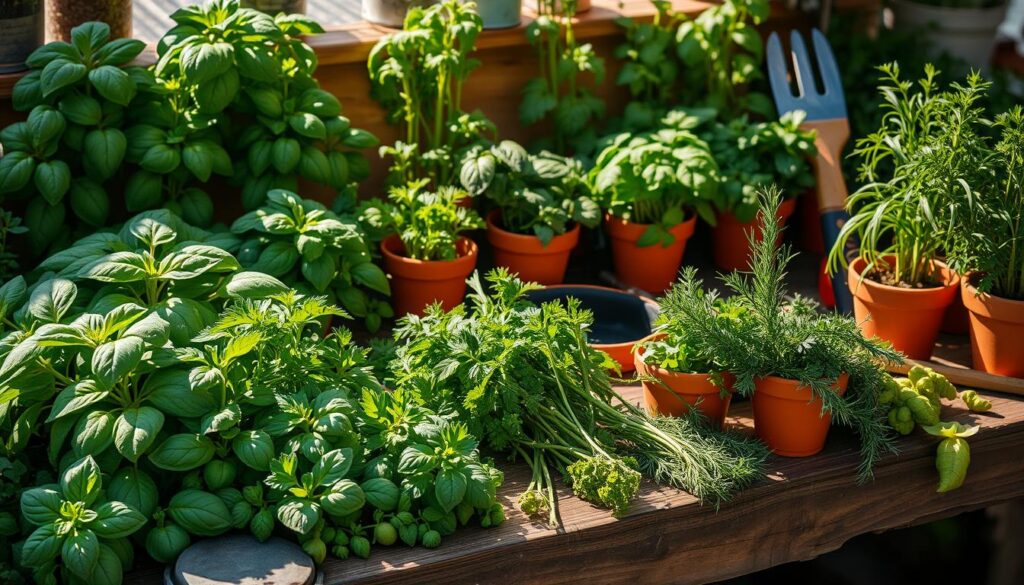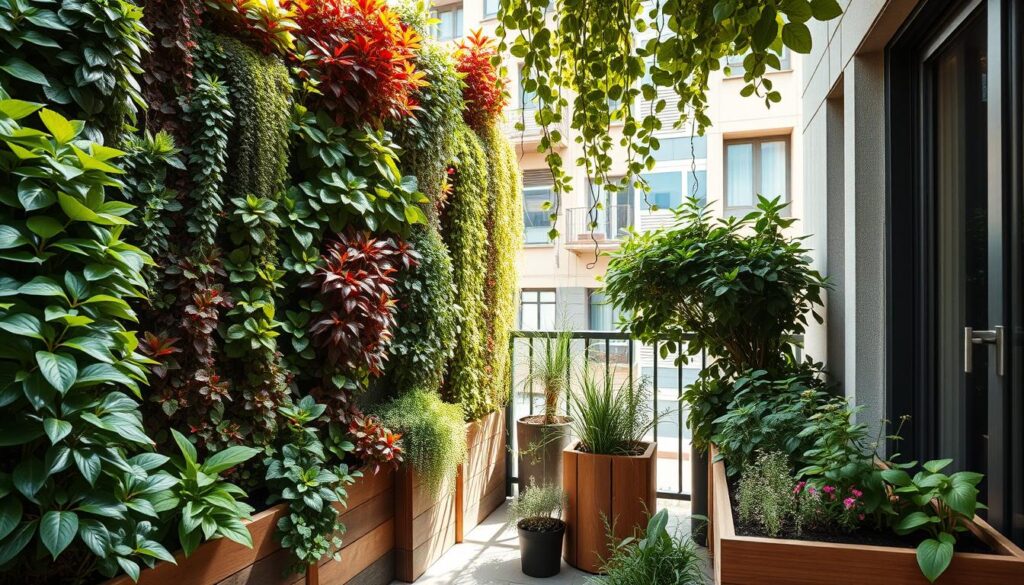How to Grow Fruits at Home: Lemons, Strawberries, Blackberries, and More
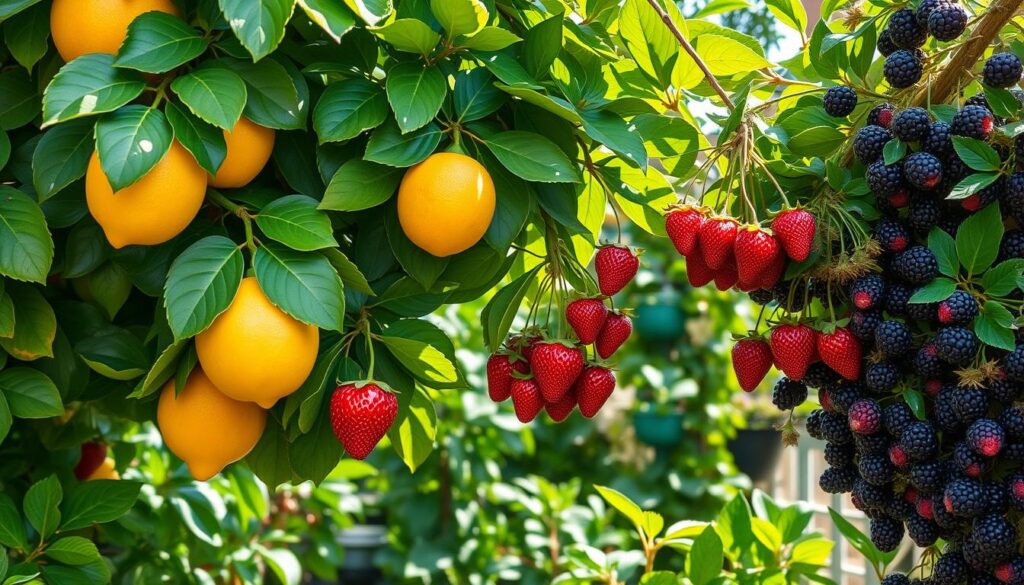
Growing fruits at home is a rewarding hobby. It lets you enjoy fresh, delicious produce in your own backyard.
Fruit gardening is perfect for beginners because it needs little space and fits many climates. With the right help, anyone can grow fruits like lemons, strawberries, blackberries, and more.
Fruit gardening is fun and rewarding for everyone. It gives you fresh, healthy food and a sense of pride.
By following simple steps and tips, you can create a thriving fruit garden. This way, you enjoy the benefits of home gardening and growing fruits.
Choosing the Right Fruits for Your Space
When growing fruits at home, fruit selection is key. Your area’s climate, available space, and the season matter a lot. Each fruit has its own needs, so knowing these helps you choose wisely.
Lemons, strawberries, and blackberries are great for home gardens. They each need different things. For instance, lemons love warm, sunny spots, while strawberries do well in cooler weather.
It’s also smart to pick seasonal fruits. Some fruits, like strawberries, are always in season. Others, like blackberries, are only around for a few months. Picking fruits in season means you get the best taste and a big harvest.
- Lemons: warm and sunny climate
- Strawberries: cooler temperatures, well-draining soil
- Blackberries: full sun, rich soil
By thinking about these points and picking the right fruits, you can have a great home garden. It’s a rewarding experience.
Preparing Your Garden or Containers
Growing fruits at home starts with garden preparation. This means picking the best soil and choosing the right containers. It also involves making sure your plants get enough sunlight.
Each fruit has its own needs for soil and sunlight, so do your research.
For soil selection, think about the fruit you’re growing and your climate. Some fruits need well-draining soil, while others like it more moist. If you’re short on space, consider container gardening.
You can grow fruits in small spaces, like balconies or patios.
Selecting the Best Soil
- Research the specific soil requirements for the fruits you want to grow
- Consider the climate and soil type in your area
- Choose a soil that is well-draining and rich in nutrients
Choosing the Right Containers
When picking containers for container gardening, think about size and material. Make sure the container is big enough for the plant when it’s fully grown. Choose a material that’s strong and can handle the weather.
Growing Lemons at Home
Growing lemons at home can be very rewarding. It gives you a steady supply of fresh lemons for cooking and drinks. Choosing the right lemon variety is key, as some are better for home gardens than others.
‘Dwarf Washington’ and ‘Dwarf Meyer’ are great for home gardeners. They are small and produce a lot of lemons.
Proper lemon tree care is vital for your tree’s health. This includes watering, fertilizing, and pruning. Also, watch out for pests like aphids and whiteflies. By using the right growing lemons methods and preventing pests, you can have a lot of fresh lemons.
Ideal Varieties for Home Gardening
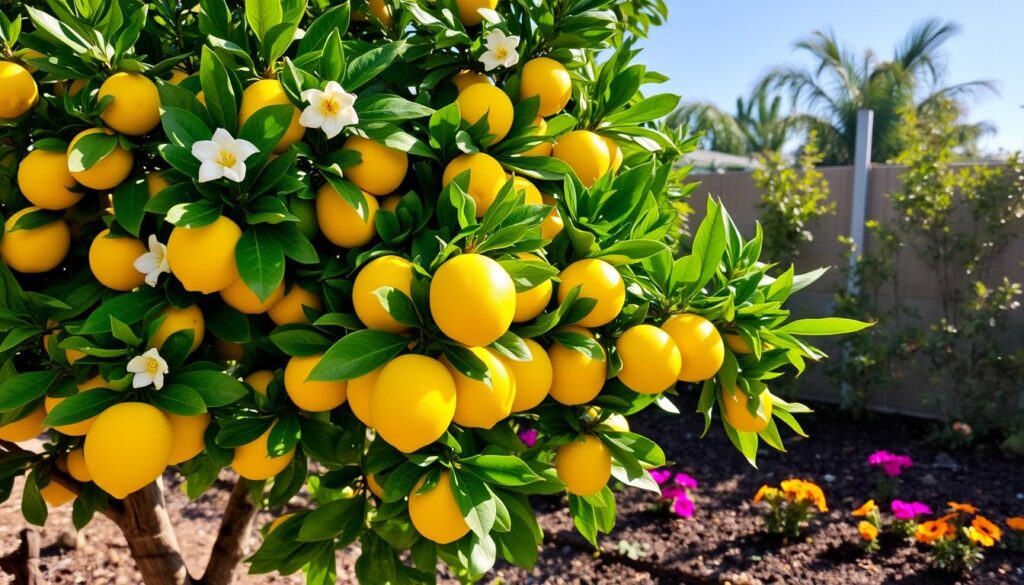
- ‘Dwarf Washington’ – a compact variety that produces large, seedless lemons
- ‘Dwarf Meyer’ – a popular choice for home gardeners, known for its high yield and sweet flavor
- ‘Ponderosa’ – a large, vigorous tree that produces large, thick-skinned lemons
Care and Maintenance Tips
To keep your lemon tree healthy, give it full sun and well-draining soil. Water it regularly. Fertilize it often with a balanced fertilizer that’s high in nitrogen.
Prune your tree every year to keep it shaped and encourage fruiting. By following these lemon tree care tips, you can have a healthy and productive tree.
Planting Strawberries Successfully
Planting strawberries can be very rewarding. You can choose from many types, like June-bearing, ever-bearing, and day-neutral. Knowing how to plant them right can make a big difference in your harvest.
Each strawberry type has its own benefits. June-bearing strawberries give a big crop in summer. Ever-bearing strawberries produce smaller crops all season.
Day-neutral strawberries make flowers and fruit no matter the day length. Picking the right type for your climate and space can lead to a great harvest.
Best Planting Techniques
To plant strawberries well, start with good soil. Add compost or manure to make the soil better. Strawberries need full sun and well-draining soil. Choose a spot that gets at least 6 hours of direct sunlight a day.
Watering and Fertilization Needs
Strawberries need regular water and food. Water them about 1 inch a week. Use a balanced fertilizer that’s high in phosphorus to help them grow fruit.
By following these steps and picking the right strawberries, you can have a great harvest all season. Some important things to remember for strawberry care are:
- Give them enough water and nutrients
- Keep them safe from pests and diseases
- Prune them often to help them grow well
By keeping these tips in mind, you can keep your strawberries healthy. This way, you’ll enjoy a big harvest of tasty strawberries.
Cultivating Blackberries in Your Garden
Blackberry cultivation can be very rewarding. But, it needs some knowledge and planning. You must decide between thornless blackberries and traditional thorny varieties. Thornless blackberries are easier to care for and pick.
But, some gardeners like the traditional thorny varieties for their unique taste and look.
There are different ways to train blackberry vines. Proper training helps use space well and promotes healthy growth. You can use a trellis, a stake, or the hill system. Each method has its own benefits and drawbacks.
- Choose a variety that fits your climate and soil
- Plant them in a sunny spot with good drainage
- Water them often, but don’t overdo it
- Keep them maintained with regular pruning and fertilizing
By following these tips and understanding the needs of thornless blackberries and vine training, you can enjoy a great harvest of tasty blackberries.
Organic Practices for Fruit Gardening
Organic gardening is key for a sustainable and healthy fruit garden. It boosts soil health, increases biodiversity, and cuts down on environmental harm. Organic gardening uses natural ways to fight pests and diseases, not chemicals.
Organic gardening has many benefits:
- It makes soil health better with organic additives
- It brings in more biodiversity, attracting good insects and pollinators
- It’s better for the environment, using less chemical pesticides and fertilizers
Benefits of Organic Gardening
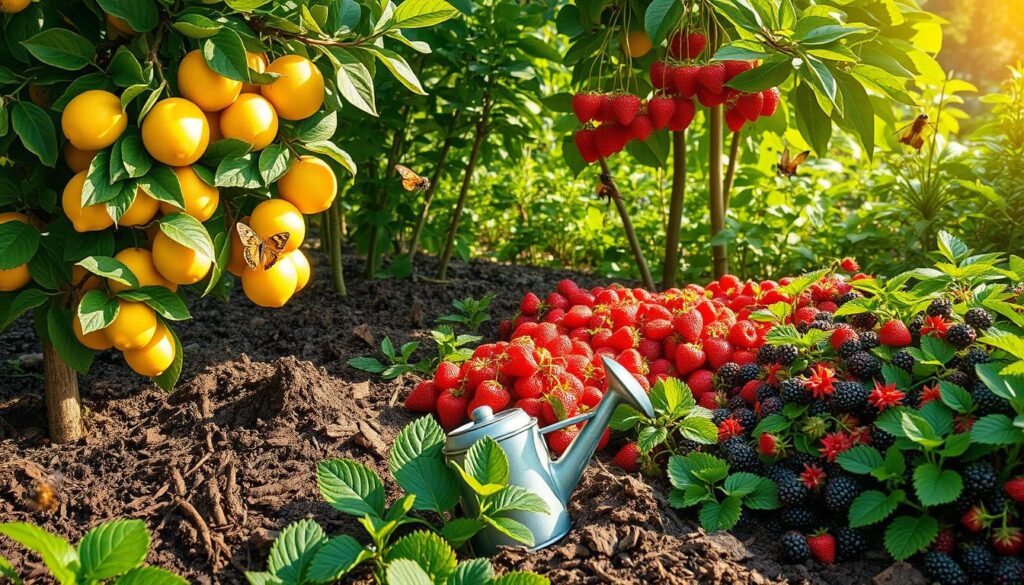
Organic gardening makes soil health better and boosts crop yields. It uses natural pest control, like beneficial insects or neem oil, instead of chemicals. This keeps the garden balanced, helping plants stay healthy and disease-free.
Natural Pest Control Methods
Organic gardening relies on natural pest control. This includes:
- Bringing in beneficial insects, like ladybugs or lacewings, to fight pests
- Using neem oil or other natural pesticides
- Keeping the garden clean by removing weeds and debris to stop pests
Soil Health and Amendments
Good soil health is vital for growing healthy fruit plants. Organic additives, like compost or manure, help improve soil. By focusing on soil health and natural pest control, gardeners can build a sustainable fruit garden. This garden benefits the environment and the community.
| Organic Amendment | Benefits |
|---|---|
| Compost | Improves soil structure and fertility |
| Manure | Provides nutrients and improves soil health |
| Neem oil | Controls pests and diseases |
Troubleshooting Common Fruit Plant Issues
Fruit plants face many problems like diseases and pests. Spotting these issues early is key to saving your plants.
Issues like powdery mildew and root rot can be fixed with fungicides or better soil. Nutrient shortages, seen as yellowing leaves or stunted growth, need a change in fertilizing. Pests like aphids or whiteflies can be controlled with hand-picking or organic sprays.
Identifying Plant Diseases
Diseases in plants come from fungi, bacteria, or viruses. They spread through contaminated soil, water, or insects. Look out for black spots, yellowing leaves, or distorted growth. Good hygiene, like cleaning tools and removing sick plants, helps stop disease spread.
Recognizing Nutrient Deficiencies
Nutrient shortages happen when plants lack important nutrients like nitrogen or potassium. Signs include yellowing leaves, stunted growth, or weak fruit production. Fixing this often means changing how you fertilize or adding organic soil amendments.
Dealing with Pest Infestations
Pests like aphids or spider mites can harm plants. Look for holes in leaves, sticky substance on plants, or actual pests. Use organic sprays, introduce beneficial insects, or keep your garden clean to fight pests.
| Common Fruit Plant Problems | Cause | Solution |
|---|---|---|
| Powdery mildew | Fungal disease | Fungicides or improved soil drainage |
| Nutrient deficiencies | Lack of essential nutrients | Adjust fertilization strategy or add organic matter |
| Pest infestations | Insects or other pests | Organic pesticides, beneficial insects, or good hygiene |
Creating a Fruit Garden Plan
Planning a fruit garden is key to success. A good plan includes a seasonal planting calendar. This ensures fresh fruits all year. Companion planting helps fruits grow better and keeps pests away.
Maximizing space and yield is also important. Choose the right fruits for your space and climate. Use vertical or container gardening to grow more in less space.
Some key considerations for fruit garden planning include:
- Seasonal planting: Plant fruits at the right time for best growth and harvest.
- Companion planting: Plant different fruits or vegetables together to improve growth or deter pests.
- Space maximization: Use efficient planting and training techniques to grow more fruits in less space.
For example, plant strawberries in spring, blackberries in summer, and lemons in fall. This way, you get fresh fruits all year. Companion planting, like marigolds with strawberries, helps keep pests away and improves health.
| Fruit | Seasonal Planting Time | Companion Planting |
|---|---|---|
| Strawberries | Spring | Marigolds, borage |
| Blackberries | Summer | Rosemary, thyme |
| Lemons | Fall | Garlic, chili peppers |
Preserving Your Fruit Harvest
Fruit preservation lets you enjoy fruits all year. You can choose from canning, freezing, and dehydrating. Each method has its own way of doing things and safety tips.
Choosing the right method for each fruit is key. Canning works well for strawberries and blueberries. Freezing is better for raspberries and blackberries.
Canning and Freezing Techniques
Canning heats fruits to kill bacteria and seals them in containers. Freezing is simpler, involving washing, cutting, and freezing. Both need careful steps to preserve fruits safely.
Dehydrating Fruits Safely
Dehydrating fruits safely means watching temperature and humidity. It’s great for apricots, apples, and bananas. You can use a dehydrator or your oven on low.
Making Jams and Jellies at Home
Making jams and jellies is fun and rewarding. It uses fruits, sugar, and pectin. It’s perfect for strawberries, blueberries, and raspberries. You can adjust it to your taste.
By using these fruit preservation methods, you can enjoy fruits all year. Whether you like canning, freezing, dehydrating, or making jams, there’s something for everyone. With practice and patience, you’ll master preserving your fruit harvest and enjoy it all year.
Enjoying the Fruits of Your Labor
When you serve your homegrown fruit, the joy of gardening is clear. You can make endless recipes, from simple salads to fancy desserts. Sharing your fruits with others brings people together and strengthens bonds.
Connecting with other gardeners is rewarding. You can share tips, swap fruits, and work on projects together. This way, you all grow better and enjoy the fruits of your labor more.
Recipe Ideas for Fresh Fruits
There are countless ways to use your fruits. Try making classic fruit salads or homemade jams. Experiment with new recipes to highlight your fruits’ unique tastes and textures.
Sharing Harvests with Friends and Family
Sharing your fruits with loved ones is a great way to share the joy of gardening. You could host a potluck, teach a cooking class, or give baskets of fresh fruits to neighbors and friends.
Building a Community of Fruit Growers
Connecting with other gardeners is enriching. You can share advice, celebrate successes, and work on projects together. This helps promote organic fruit growing in your area.
Recommended Content: How to Start a Home Garden from Scratch
